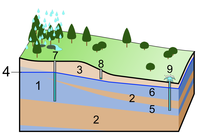
Photo from wikipedia
The temporal and spatial monitoring of groundwater levels is among the most widely used techniques for understanding groundwater reserves, which is essential for the management of regions with drought-related issues.… Click to show full abstract
The temporal and spatial monitoring of groundwater levels is among the most widely used techniques for understanding groundwater reserves, which is essential for the management of regions with drought-related issues. Between 2010 and 2017, the Brazilian semi-arid region suffered a severe drought, presenting intensity and societal impacts undetected in decades. This research aimed to understand how Gravity Recovery and Climate Experiment (GRACE) data can be used as a tool for monitoring groundwater reserves in one of the most important aquifers in the Araripe Sedimentary Basin (Middle Aquifer System), located in a developing region with scarce amounts of data, and where 84,000,000 m3 of groundwater is abstracted annually through pumping. Groundwater storage (GWS) in-situ data were related to GWS estimates based on a combination of GRACE-based terrestrial water storage (TWS with both mascon and spherical harmonic solutions) and Global Land Data Assimilation System (GLDAS) soil moisture (CLM, MOS, NOAH and VIC models were evaluated). Results were analyzed with Nash-Sutcliffe (NS) and Pearson correlation coefficient metrics, and showed that the GWS GRACE-based estimate using the Community Land Model (CLM) land-surface model was more suitable for representing aquifer storage variations. Seven wells (58%) demonstrated a NS > 0.50 for both GWS GRACE-based solutions. In conclusion, GWS GRACE-based methodology has potential for monitoring the 1,394-km2 outcrop area of the Middle Aquifer System.
Journal Title: Hydrogeology Journal
Year Published: 2019
Link to full text (if available)
Share on Social Media: Sign Up to like & get
recommendations!